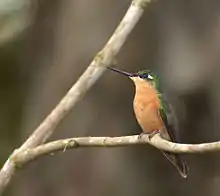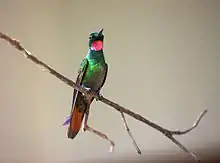Brazilian ruby
The Brazilian ruby (Clytolaema rubricauda) is a species of hummingbird found in forest edge, second growth, gardens and parks in eastern Brazil. It is the only species placed in the genus Clytolaema. It is common and among the species regularly seen at hummingbird feeders within its range. It is a relatively large hummingbird. The male is overall green with a coppery back and rump, a coppery-rufous tail and, as suggested by its common name, a highly iridescent ruby throat that can appear black from some angles. Females are green above and cinnamon below. Both sexes have a white post-ocular spot and a straight black bill.
| Brazilian ruby | |
|---|---|
 | |
| female | |
 | |
| male | |
| Scientific classification | |
| Kingdom: | Animalia |
| Phylum: | Chordata |
| Class: | Aves |
| Order: | Apodiformes |
| Family: | Trochilidae |
| Tribe: | Heliantheini |
| Genus: | Clytolaema Gould, 1853 |
| Species: | C. rubricauda |
| Binomial name | |
| Clytolaema rubricauda (Boddaert, 1783) | |
Taxonomy
The Brazilian ruby was described by the French polymath Georges-Louis Leclerc, Comte de Buffon in 1780 in his Histoire Naturelle des Oiseaux.[2] The bird was also illustrated in a hand-coloured plate engraved by François-Nicolas Martinet in the Planches Enluminées D'Histoire Naturelle which was produced under the supervision of Edme-Louis Daubenton to accompany Buffon's text.[3] Neither the plate caption nor Buffon's description included a scientific name but in 1783 the Dutch naturalist Pieter Boddaert coined the binomial name Trochilus rubicauda in his catalogue of the Planches Enluminées.[4] The Brazilian ruby is the now the only species placed in the genus Clytolaema that was introduced by the ornithologist and bird artist John Gould in 1853.[5][6] The type locality is Rio de Janeiro in Brazil.[7] The species is monotypic.[6]
The generic name combines the Ancient Greek klutos meaning "glorious" and laimos meaning "throat". The specific epithet rubricauda combines the Latin ruber meaning "red" and cauda meaning "tail".[8]
References
- BirdLife International (2012). "Clytolaema rubricauda". IUCN Red List of Threatened Species. 2012. Retrieved 26 November 2013.
- Buffon, Georges-Louis Leclerc de (1780). "Le rubis émeraude". Histoire Naturelle des Oiseaux (in French). Volume 11. Paris: De L'Imprimerie Royale. p. 43.
- Buffon, Georges-Louis Leclerc de; Martinet, François-Nicolas; Daubenton, Edme-Louis; Daubenton, Louis-Jean-Marie (1765–1783). "Oiseau-mouche à gorge rouge, de Bresil". Planches Enluminées D'Histoire Naturelle. Volume 3. Paris: De L'Imprimerie Royale. Plate 276 Fig. 4.
- Boddaert, Pieter (1783). Table des planches enluminéez d'histoire naturelle de M. D'Aubenton : avec les denominations de M.M. de Buffon, Brisson, Edwards, Linnaeus et Latham, precedé d'une notice des principaux ouvrages zoologiques enluminés (in French). Utrecht. p. 17, Number 276 Fig. 4.
- Gould, John (1853). A Monograph of the Trochilidae, or Family of Humming-Birds. Volume 4. London: self. Plate 249 and text (Part 6 Plate 2). The 5 volumes were issued in 25 parts between 1849 and 1861. Title pages of all volumes bear the date of 1861.
- Gill, Frank; Donsker, David, eds. (2019). "Hummingbirds". World Bird List Version 9.2. International Ornithologists' Union. Archived from the original on 2 October 2018. Retrieved 22 July 2019.
- Peters, James Lee, ed. (1945). Check-list of Birds of the World. Volume 5. Cambridge, Massachusetts: Harvard University Press. p. 86.
- Jobling, James A. (2010). The Helm Dictionary of Scientific Bird Names. London: Christopher Helm. pp. 111, 340. ISBN 978-1-4081-2501-4.
- Sick, H. (1993). Birds in Brazil: A Natural History. Princeton University Press. ISBN 0-691-08569-2
